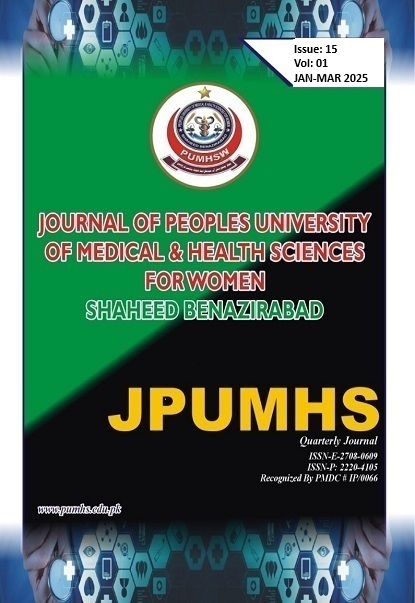ANALYZING MENTAL HEALTH DISORDER RATES AMONG PRIVATE SECTOR MEDICAL STUDENTS: TACKLING GENDER DISPARITIES.
JPUMHS; 2025:15:01,4-12. http://doi.org/10.46536/jpumhs/2025/15.01.589
Keywords:
KEYWORDS: Mental health disorders, Undergraduate students, Prevalence, Gender disparities, University wellness servicesAbstract
ABSTRACT
BACKGROUND: This study investigates the frequency of Mental Health Disorders among
students at Private sector medical college and university with a specific focus on the mental
health challenges faced by undergraduate students. OBJECTIVE: This study aims to explore
the prevalence of these mental health disorders between university students and to identify
key risk factors, providing insights for targeted interventions to support student well-being.
METHODOLOGY: A total of 247 students (166 females and 81 male) from different
programs, including MBBS (132 participants), BDS (44 participants), and other medical
disciplines (71 participants), participated in this cross-sectional study. Random sampling was
used to choose participants according to their educational attainment, gender, and field of
study. Students who had used on-campus wellness and counseling services met the inclusion
criterion, whereas those who had never used these services were not included. This study
employed six established instruments to evaluate mental health conditions, including the
GAD-7 (generalized anxiety disorder-7) to screen for generalized anxiety disorder, the PHQ
9 (patient health questionnaire-9) to gauge the severity of depression, and the PHQ-15 to
measure somatic symptoms. Obsessive-compulsive disorder symptoms were evaluated using
the OCI-R (obsessive-compulsive inventory-n revised). SPIN was used for social anxiety, and
the severity measures for specific phobia and panic disorder, both showing strong validity and
reliability. The DAST-10 (drug abuse screening test) was used to assess substance use.
RESULTS: Results indicated a high prevalence of mental health disorders: 58.9% for somatic
symptom disorder, 39.9% for depression, 22.3% for generalized anxiety disorder, and 48%
for obsessive-compulsive disorder and 4.1% in substance-use disorder. Notably, female
students exhibited significantly higher scores in depression and anxiety disorders compared
to their male counterparts. Significant comorbidities were observed, with depression
frequently co-occurring with somatic symptom disorder and anxiety disorders.
CONCLUSION: Enhancing mental health resources and support systems within university
settings is crucial to promote student well-being and academic success. Further research is recommended to explore the underlying causes of these gender disparities in mental health.
Downloads
Downloads
Published
How to Cite
Issue
Section
License

This work is licensed under a Creative Commons Attribution-NoDerivatives 4.0 International License.




